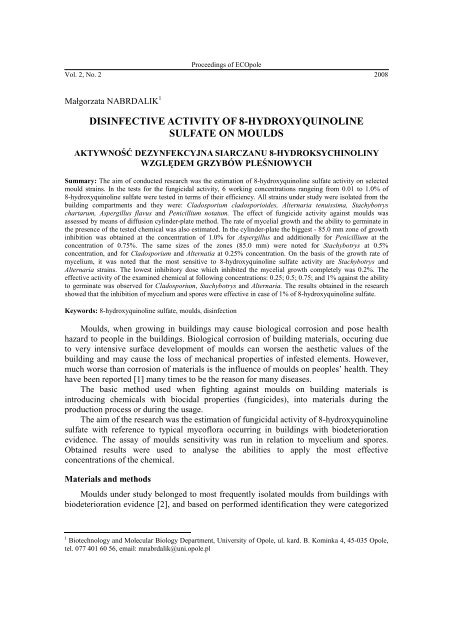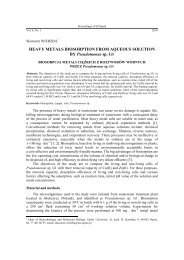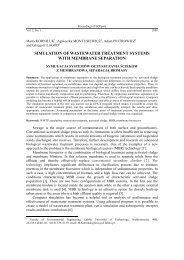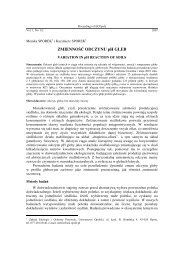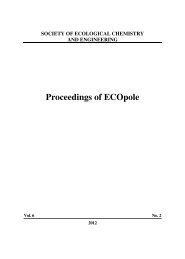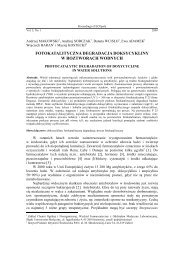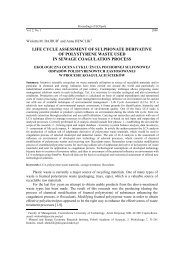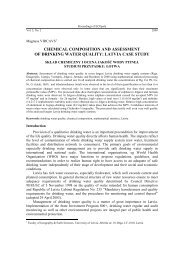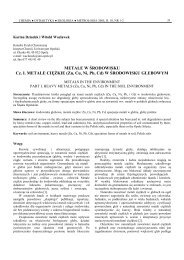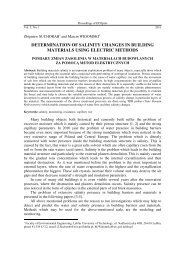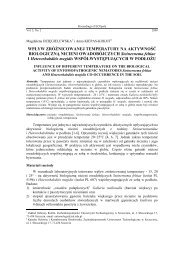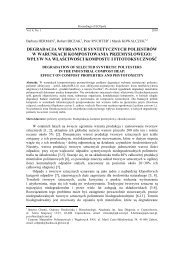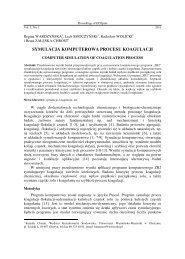disinfective activity of 8-hydroxyquinoline sulfate on moulds
disinfective activity of 8-hydroxyquinoline sulfate on moulds
disinfective activity of 8-hydroxyquinoline sulfate on moulds
You also want an ePaper? Increase the reach of your titles
YUMPU automatically turns print PDFs into web optimized ePapers that Google loves.
Proceedings <str<strong>on</strong>g>of</str<strong>on</strong>g> ECOpole<br />
Vol. 2, No. 2 2008<br />
Małgorzata NABRDALIK 1<br />
DISINFECTIVE ACTIVITY OF 8-HYDROXYQUINOLINE<br />
SULFATE ON MOULDS<br />
AKTYWNOŚĆ DEZYNFEKCYJNA SIARCZANU 8-HYDROKSYCHINOLINY<br />
WZGLĘDEM GRZYBÓW PLEŚNIOWYCH<br />
Summary: The aim <str<strong>on</strong>g>of</str<strong>on</strong>g> c<strong>on</strong>ducted research was the estimati<strong>on</strong> <str<strong>on</strong>g>of</str<strong>on</strong>g> 8-<str<strong>on</strong>g>hydroxyquinoline</str<strong>on</strong>g> <str<strong>on</strong>g>sulfate</str<strong>on</strong>g> <str<strong>on</strong>g>activity</str<strong>on</strong>g> <strong>on</strong> selected<br />
mould strains. In the tests for the fungicidal <str<strong>on</strong>g>activity</str<strong>on</strong>g>, 6 working c<strong>on</strong>centrati<strong>on</strong>s rangeing from 0.01 to 1.0% <str<strong>on</strong>g>of</str<strong>on</strong>g><br />
8-<str<strong>on</strong>g>hydroxyquinoline</str<strong>on</strong>g> <str<strong>on</strong>g>sulfate</str<strong>on</strong>g> were tested in terms <str<strong>on</strong>g>of</str<strong>on</strong>g> their efficiency. All strains under study were isolated from the<br />
building compartments and they were: Cladosporium cladosporioides, Alternaria tenuissima, Stachybotrys<br />
chartarum, Aspergillus flavus and Penicillium notatum. The effect <str<strong>on</strong>g>of</str<strong>on</strong>g> fungicide <str<strong>on</strong>g>activity</str<strong>on</strong>g> against <strong>moulds</strong> was<br />
assessed by means <str<strong>on</strong>g>of</str<strong>on</strong>g> diffusi<strong>on</strong> cylinder-plate method. The rate <str<strong>on</strong>g>of</str<strong>on</strong>g> mycelial growth and the ability to germinate in<br />
the presence <str<strong>on</strong>g>of</str<strong>on</strong>g> the tested chemical was also estimated. In the cylinder-plate the biggest - 85.0 mm z<strong>on</strong>e <str<strong>on</strong>g>of</str<strong>on</strong>g> growth<br />
inhibiti<strong>on</strong> was obtained at the c<strong>on</strong>centrati<strong>on</strong> <str<strong>on</strong>g>of</str<strong>on</strong>g> 1.0% for Aspergillus and additi<strong>on</strong>ally for Penicillium at the<br />
c<strong>on</strong>centrati<strong>on</strong> <str<strong>on</strong>g>of</str<strong>on</strong>g> 0.75%. The same sizes <str<strong>on</strong>g>of</str<strong>on</strong>g> the z<strong>on</strong>es (85.0 mm) were noted for Stachybotrys at 0.5%<br />
c<strong>on</strong>centrati<strong>on</strong>, and for Cladosporium and Alternatia at 0.25% c<strong>on</strong>centrati<strong>on</strong>. On the basis <str<strong>on</strong>g>of</str<strong>on</strong>g> the growth rate <str<strong>on</strong>g>of</str<strong>on</strong>g><br />
mycelium, it was noted that the most sensitive to 8-<str<strong>on</strong>g>hydroxyquinoline</str<strong>on</strong>g> <str<strong>on</strong>g>sulfate</str<strong>on</strong>g> <str<strong>on</strong>g>activity</str<strong>on</strong>g> are Stachybotrys and<br />
Alternaria strains. The lowest inhibitory dose which inhibited the mycelial growth completely was 0.2%. The<br />
effective <str<strong>on</strong>g>activity</str<strong>on</strong>g> <str<strong>on</strong>g>of</str<strong>on</strong>g> the examined chemical at following c<strong>on</strong>centrati<strong>on</strong>s: 0.25; 0.5; 0.75; and 1% against the ability<br />
to germinate was observed for Cladosporium, Stachybotrys and Alternaria. The results obtained in the research<br />
showed that the inhibiti<strong>on</strong> <str<strong>on</strong>g>of</str<strong>on</strong>g> mycelium and spores were effective in case <str<strong>on</strong>g>of</str<strong>on</strong>g> 1% <str<strong>on</strong>g>of</str<strong>on</strong>g> 8-<str<strong>on</strong>g>hydroxyquinoline</str<strong>on</strong>g> <str<strong>on</strong>g>sulfate</str<strong>on</strong>g>.<br />
Keywords: 8-<str<strong>on</strong>g>hydroxyquinoline</str<strong>on</strong>g> <str<strong>on</strong>g>sulfate</str<strong>on</strong>g>, <strong>moulds</strong>, disinfecti<strong>on</strong><br />
Moulds, when growing in buildings may cause biological corrosi<strong>on</strong> and pose health<br />
hazard to people in the buildings. Biological corrosi<strong>on</strong> <str<strong>on</strong>g>of</str<strong>on</strong>g> building materials, occuring due<br />
to very intensive surface development <str<strong>on</strong>g>of</str<strong>on</strong>g> <strong>moulds</strong> can worsen the aesthetic values <str<strong>on</strong>g>of</str<strong>on</strong>g> the<br />
building and may cause the loss <str<strong>on</strong>g>of</str<strong>on</strong>g> mechanical properties <str<strong>on</strong>g>of</str<strong>on</strong>g> infested elements. However,<br />
much worse than corrosi<strong>on</strong> <str<strong>on</strong>g>of</str<strong>on</strong>g> materials is the influence <str<strong>on</strong>g>of</str<strong>on</strong>g> <strong>moulds</strong> <strong>on</strong> peoples’ health. They<br />
have been reported [1] many times to be the reas<strong>on</strong> for many diseases.<br />
The basic method used when fighting against <strong>moulds</strong> <strong>on</strong> building materials is<br />
introducing chemicals with biocidal properties (fungicides), into materials during the<br />
producti<strong>on</strong> process or during the usage.<br />
The aim <str<strong>on</strong>g>of</str<strong>on</strong>g> the research was the estimati<strong>on</strong> <str<strong>on</strong>g>of</str<strong>on</strong>g> fungicidal <str<strong>on</strong>g>activity</str<strong>on</strong>g> <str<strong>on</strong>g>of</str<strong>on</strong>g> 8-<str<strong>on</strong>g>hydroxyquinoline</str<strong>on</strong>g><br />
<str<strong>on</strong>g>sulfate</str<strong>on</strong>g> with reference to typical myc<str<strong>on</strong>g>of</str<strong>on</strong>g>lora occurring in buildings with biodeteriorati<strong>on</strong><br />
evidence. The assay <str<strong>on</strong>g>of</str<strong>on</strong>g> <strong>moulds</strong> sensitivity was run in relati<strong>on</strong> to mycelium and spores.<br />
Obtained results were used to analyse the abilities to apply the most effective<br />
c<strong>on</strong>centrati<strong>on</strong>s <str<strong>on</strong>g>of</str<strong>on</strong>g> the chemical.<br />
Materials and methods<br />
Moulds under study bel<strong>on</strong>ged to most frequently isolated <strong>moulds</strong> from buildings with<br />
biodeteriorati<strong>on</strong> evidence [2], and based <strong>on</strong> performed identificati<strong>on</strong> they were categorized<br />
1 Biotechnology and Molecular Biology Department, University <str<strong>on</strong>g>of</str<strong>on</strong>g> Opole, ul. kard. B. Kominka 4, 45-035 Opole,<br />
tel. 077 401 60 56, email: mnabrdalik@uni.opole.pl
354<br />
Małgorzata Nabrdalik<br />
as: Alternaria tenuissima, Aspergillus flavus, Cladosporium cladosporioides, Penicillium<br />
notatum, Stachybotrys chartarum.<br />
In the tests for fungicidal <str<strong>on</strong>g>activity</str<strong>on</strong>g>, the efficacy <str<strong>on</strong>g>of</str<strong>on</strong>g> 8-<str<strong>on</strong>g>hydroxyquinoline</str<strong>on</strong>g> <str<strong>on</strong>g>sulfate</str<strong>on</strong>g> was<br />
tested in 6 working c<strong>on</strong>centrati<strong>on</strong>s <str<strong>on</strong>g>of</str<strong>on</strong>g>: 0.01, 0.1, 0.25, 0.5, 0.75 and 1.0%.<br />
The fungicidal <str<strong>on</strong>g>activity</str<strong>on</strong>g> <str<strong>on</strong>g>of</str<strong>on</strong>g> 8-<str<strong>on</strong>g>hydroxyquinoline</str<strong>on</strong>g> <str<strong>on</strong>g>sulfate</str<strong>on</strong>g> was assessed <strong>on</strong> the basis <str<strong>on</strong>g>of</str<strong>on</strong>g>: the<br />
cylinder-plate diffusi<strong>on</strong> method, the intensity <str<strong>on</strong>g>of</str<strong>on</strong>g> mycelial growth rate and the ability <str<strong>on</strong>g>of</str<strong>on</strong>g><br />
spores to germinate.<br />
Fungicidal <str<strong>on</strong>g>activity</str<strong>on</strong>g> <str<strong>on</strong>g>of</str<strong>on</strong>g> the chemical applied was assessed with the modified cylinderplate<br />
diffusi<strong>on</strong> method. The dishes were poured with 20 cm 3 <str<strong>on</strong>g>of</str<strong>on</strong>g> Sabourauda medium<br />
inoculated with particular <strong>moulds</strong> species and the mixture <str<strong>on</strong>g>of</str<strong>on</strong>g> the spores <str<strong>on</strong>g>of</str<strong>on</strong>g> the tested <strong>moulds</strong><br />
(<str<strong>on</strong>g>of</str<strong>on</strong>g> 1×10 6 cell/cm 3 density). The wells were filled with 0.2 cm 3 <str<strong>on</strong>g>of</str<strong>on</strong>g> the tested chemical in<br />
respective c<strong>on</strong>centrati<strong>on</strong>s. The c<strong>on</strong>trol treatment was the wells filled with sterile water. The<br />
samples were incubated at 25 o C for 3 weeks. The <str<strong>on</strong>g>disinfective</str<strong>on</strong>g> efficacy <str<strong>on</strong>g>of</str<strong>on</strong>g> the tested<br />
chemical was assessed <strong>on</strong> the basis <str<strong>on</strong>g>of</str<strong>on</strong>g> the growth inhibiti<strong>on</strong> z<strong>on</strong>es.<br />
The indicati<strong>on</strong> <str<strong>on</strong>g>of</str<strong>on</strong>g> fungicidal <str<strong>on</strong>g>activity</str<strong>on</strong>g> based <strong>on</strong> the intensity <str<strong>on</strong>g>of</str<strong>on</strong>g> mycelial growth rate was<br />
c<strong>on</strong>ducted <strong>on</strong> Sabourauda medium with the additi<strong>on</strong> <str<strong>on</strong>g>of</str<strong>on</strong>g> the c<strong>on</strong>secutive c<strong>on</strong>centrati<strong>on</strong>s <str<strong>on</strong>g>of</str<strong>on</strong>g><br />
the chemical. Agar discs <str<strong>on</strong>g>of</str<strong>on</strong>g> 10 mm diameter overgrown with 2-week mycelium <str<strong>on</strong>g>of</str<strong>on</strong>g> tested<br />
<strong>moulds</strong> were placed <strong>on</strong> the medium <strong>on</strong> Petri dishes. The c<strong>on</strong>trol treatment was prepared <strong>on</strong><br />
a Petri dish with Sabourauda medium (without the chemical) and mycelium disc. The<br />
diameter <str<strong>on</strong>g>of</str<strong>on</strong>g> mould col<strong>on</strong>ies was measured every 3 days, from the beginning <str<strong>on</strong>g>of</str<strong>on</strong>g> the mycelial<br />
growth recorded in the c<strong>on</strong>trol dishes. The samples were incubated at 25°C.<br />
The <str<strong>on</strong>g>activity</str<strong>on</strong>g> <str<strong>on</strong>g>of</str<strong>on</strong>g> tested chemical against the mycelial growth was assessed <strong>on</strong> the basis <str<strong>on</strong>g>of</str<strong>on</strong>g> the<br />
growth rate index (T), calculated with the following formula [3, 4]:<br />
A b1<br />
b<br />
T = + + ... +<br />
D d d<br />
where: T - growth rate index, A - the mean value <str<strong>on</strong>g>of</str<strong>on</strong>g> col<strong>on</strong>y diameter measurement [mm],<br />
D - the length <str<strong>on</strong>g>of</str<strong>on</strong>g> an experiment [days], b1, b2, bx - increase in diameter since the last<br />
measurement, d1, d2, dx - number <str<strong>on</strong>g>of</str<strong>on</strong>g> days passed since the last measurement.<br />
Indicati<strong>on</strong> <str<strong>on</strong>g>of</str<strong>on</strong>g> fungicidal <str<strong>on</strong>g>activity</str<strong>on</strong>g> was also tested <strong>on</strong> the basis <str<strong>on</strong>g>of</str<strong>on</strong>g> the spores’ ability to<br />
germinate. For this purpose 0.02 cm 3 <str<strong>on</strong>g>of</str<strong>on</strong>g> the c<strong>on</strong>secutive c<strong>on</strong>cetrati<strong>on</strong>s <str<strong>on</strong>g>of</str<strong>on</strong>g><br />
8-<str<strong>on</strong>g>hydroxyquinoline</str<strong>on</strong>g> <str<strong>on</strong>g>sulfate</str<strong>on</strong>g> were placed <strong>on</strong> the 1 cm 2 <str<strong>on</strong>g>of</str<strong>on</strong>g> the slide. After drying, preparati<strong>on</strong>s<br />
were inoculated with 0.02 cm 3 <str<strong>on</strong>g>of</str<strong>on</strong>g> the suspensi<strong>on</strong> c<strong>on</strong>taining spores <str<strong>on</strong>g>of</str<strong>on</strong>g> the tested <strong>moulds</strong>.<br />
The density <str<strong>on</strong>g>of</str<strong>on</strong>g> inoculum was selected in a way that in the field <str<strong>on</strong>g>of</str<strong>on</strong>g> visi<strong>on</strong> under a medium<br />
magnificati<strong>on</strong> <str<strong>on</strong>g>of</str<strong>on</strong>g> a microscope 50÷60 spores were observed. The germinati<strong>on</strong> <str<strong>on</strong>g>of</str<strong>on</strong>g> 50 spores<br />
was assessed after 24 hours in the field <str<strong>on</strong>g>of</str<strong>on</strong>g> visi<strong>on</strong> under a microscope. When rating<br />
germinati<strong>on</strong>, the scale from 0 to 4 introduced by Burgieł [3, 4] was used.<br />
The influence <str<strong>on</strong>g>of</str<strong>on</strong>g> tested chemicals <strong>on</strong> the development <str<strong>on</strong>g>of</str<strong>on</strong>g> mould spores was assessed <strong>on</strong> the<br />
basis <str<strong>on</strong>g>of</str<strong>on</strong>g> the spores germinati<strong>on</strong> index, calculated with the formula:<br />
1<br />
( n × a)<br />
× 100<br />
=<br />
× 4<br />
∑ I<br />
N<br />
where: I - spores germinati<strong>on</strong> index, n - number <str<strong>on</strong>g>of</str<strong>on</strong>g> the spores in the specific grade <strong>on</strong> the<br />
scale, a - grade <strong>on</strong> the scale, N - general number <str<strong>on</strong>g>of</str<strong>on</strong>g> the counted spores, 4 - the highest grade<br />
<str<strong>on</strong>g>of</str<strong>on</strong>g> the scale.<br />
x<br />
x
Results<br />
Disinfective <str<strong>on</strong>g>activity</str<strong>on</strong>g> <str<strong>on</strong>g>of</str<strong>on</strong>g> 8-<str<strong>on</strong>g>hydroxyquinoline</str<strong>on</strong>g> <str<strong>on</strong>g>sulfate</str<strong>on</strong>g> <strong>on</strong> <strong>moulds</strong><br />
8-<str<strong>on</strong>g>hydroxyquinoline</str<strong>on</strong>g> <str<strong>on</strong>g>sulfate</str<strong>on</strong>g> (C9H7NO)2·H2SO4 is a chemical with known bacteriocidal<br />
and fungicidal properties, which has not been used so far against <strong>moulds</strong> growing <strong>on</strong><br />
building materials.<br />
Assay <str<strong>on</strong>g>of</str<strong>on</strong>g> biocidal <str<strong>on</strong>g>activity</str<strong>on</strong>g> <str<strong>on</strong>g>of</str<strong>on</strong>g> tested chemicals was based <strong>on</strong> the size <str<strong>on</strong>g>of</str<strong>on</strong>g> the growth<br />
inhibiti<strong>on</strong> z<strong>on</strong>e, measured in mm. In case <str<strong>on</strong>g>of</str<strong>on</strong>g> 8-<str<strong>on</strong>g>hydroxyquinoline</str<strong>on</strong>g> <str<strong>on</strong>g>sulfate</str<strong>on</strong>g> the lowest<br />
c<strong>on</strong>centrati<strong>on</strong> <str<strong>on</strong>g>of</str<strong>on</strong>g> the chemical was taken into account above which no significant<br />
differences were noted but the biggest growth inhibiti<strong>on</strong> z<strong>on</strong>es were obtained. The biggest -<br />
85.0 mm z<strong>on</strong>es were obtained in the c<strong>on</strong>centrati<strong>on</strong> <str<strong>on</strong>g>of</str<strong>on</strong>g> 1.0% for Aspergillus and the mixed<br />
treatment and additi<strong>on</strong>ally for Penicillium in the c<strong>on</strong>centrati<strong>on</strong> <str<strong>on</strong>g>of</str<strong>on</strong>g> 0.75%. The same sizes <str<strong>on</strong>g>of</str<strong>on</strong>g><br />
the z<strong>on</strong>es (85.0 mm) were noted for Stachybotrys in 0.5% c<strong>on</strong>centrati<strong>on</strong> and for<br />
Cladosporium and Alternaria in 0.25% c<strong>on</strong>centrati<strong>on</strong>. The increase in c<strong>on</strong>centrati<strong>on</strong>s in all<br />
cases did not have an effect <strong>on</strong> the size <str<strong>on</strong>g>of</str<strong>on</strong>g> the z<strong>on</strong>es and the differences between them were<br />
not significant (Table 1).<br />
Z<strong>on</strong>es <str<strong>on</strong>g>of</str<strong>on</strong>g> the growth inhibiti<strong>on</strong> <str<strong>on</strong>g>of</str<strong>on</strong>g> tested <strong>moulds</strong> in the presence <str<strong>on</strong>g>of</str<strong>on</strong>g> 8-<str<strong>on</strong>g>hydroxyquinoline</str<strong>on</strong>g> <str<strong>on</strong>g>sulfate</str<strong>on</strong>g><br />
355<br />
Table 1<br />
Mould strain C<strong>on</strong>trol<br />
0.01<br />
C<strong>on</strong>centrati<strong>on</strong> <str<strong>on</strong>g>of</str<strong>on</strong>g> applied chemical [%]<br />
0.1 0.25 0.50 0.75 1.0<br />
Penicillium 10.00 a 10.00 a 10.00 a 60.83 b 70.00 c 85.00 d 85.00 d<br />
Aspergillus 10.00 a 10.00 a 10.00 a 10.00 a 10.00 a 10.00 a 85.00 b<br />
Cladosporium 10.00 a 10.00 a 16.33 b 85.00 c 85.00 c 85.00 c 85.00 c<br />
Stachybotrys 10.00 a 10.00 a 10.00 a 10.00 a 85.00 b 85.00 b 85.00 b<br />
Alternaria 10.00 a 10.00 a 10.00 a 85.00 b 85.00 b 85.00 b 85.00 b<br />
Mixed treatment 10.00 a 10.00 a 10.00 a 10.00 a 10.00 a 10.00 a 85.00 b<br />
lower case - significant differences (p ≤ 0.05)<br />
The values <str<strong>on</strong>g>of</str<strong>on</strong>g> inhibiti<strong>on</strong> z<strong>on</strong>es were evaluated <strong>on</strong> the basis <str<strong>on</strong>g>of</str<strong>on</strong>g> obtained results and<br />
c<strong>on</strong>tributed to a specificati<strong>on</strong> <str<strong>on</strong>g>of</str<strong>on</strong>g> three mould groups according to their <str<strong>on</strong>g>activity</str<strong>on</strong>g>:<br />
1 st group - z<strong>on</strong>e <str<strong>on</strong>g>of</str<strong>on</strong>g> the growth inhibiti<strong>on</strong> below 40 mm - resistant strain,<br />
2 nd group - z<strong>on</strong>e <str<strong>on</strong>g>of</str<strong>on</strong>g> the growth inhibiti<strong>on</strong> 40÷60 mm - medium-sensitive strain,<br />
3 rd group - z<strong>on</strong>e <str<strong>on</strong>g>of</str<strong>on</strong>g> the growth inhibiti<strong>on</strong> above 60 mm - sensitive strain.<br />
In order to obtain the value <str<strong>on</strong>g>of</str<strong>on</strong>g> the inhibiti<strong>on</strong> z<strong>on</strong>e above 40 mm, for all <str<strong>on</strong>g>of</str<strong>on</strong>g> the strains at<br />
the same time, the 8-<str<strong>on</strong>g>hydroxyquinoline</str<strong>on</strong>g> <str<strong>on</strong>g>sulfate</str<strong>on</strong>g> should be applied in the c<strong>on</strong>cetrati<strong>on</strong> <str<strong>on</strong>g>of</str<strong>on</strong>g><br />
1.0%.<br />
The <str<strong>on</strong>g>activity</str<strong>on</strong>g> <str<strong>on</strong>g>of</str<strong>on</strong>g> 8-<str<strong>on</strong>g>hydroxyquinoline</str<strong>on</strong>g> <str<strong>on</strong>g>sulfate</str<strong>on</strong>g> <strong>on</strong> the linear growth <str<strong>on</strong>g>of</str<strong>on</strong>g> mycelium <str<strong>on</strong>g>of</str<strong>on</strong>g> tested<br />
<strong>moulds</strong> was determined <strong>on</strong> the basis <str<strong>on</strong>g>of</str<strong>on</strong>g> the growth rate index (GRI). In the c<strong>on</strong>ducted test,<br />
the diameter <str<strong>on</strong>g>of</str<strong>on</strong>g> the col<strong>on</strong>ies [mm] growing <strong>on</strong> the media c<strong>on</strong>taining c<strong>on</strong>secutive<br />
c<strong>on</strong>centrati<strong>on</strong>s <str<strong>on</strong>g>of</str<strong>on</strong>g> the chemical was measured including the increase in the diameter at time<br />
intervals. The objective was to find the lowest c<strong>on</strong>centrati<strong>on</strong> for which the GRI had low<br />
values, statistically significant in respect to the c<strong>on</strong>trol treatments.<br />
The most sensitive to 8-<str<strong>on</strong>g>hydroxyquinoline</str<strong>on</strong>g> <str<strong>on</strong>g>sulfate</str<strong>on</strong>g> were Stachybotrys and Alternaria<br />
strains. The lowest inhibitory dose which inhibited the mycelial growth completely was<br />
0.25%. Slightly higher c<strong>on</strong>centrati<strong>on</strong> - 0.5% inhibited Cladosporium, and the next <strong>on</strong>e -<br />
0.75% was the lowest inhibitory c<strong>on</strong>centrati<strong>on</strong> to Aspergillus. In case <str<strong>on</strong>g>of</str<strong>on</strong>g> Penicillium and the<br />
mixed treatment, the c<strong>on</strong>centrati<strong>on</strong> which inhibited the growth was 1%. For all other
356<br />
Małgorzata Nabrdalik<br />
c<strong>on</strong>centrati<strong>on</strong>s, the growth <str<strong>on</strong>g>of</str<strong>on</strong>g> tested <strong>moulds</strong> was not observed above the lowest inhibitory<br />
value (GRI = 0) (Table 2).<br />
The growth rate index <str<strong>on</strong>g>of</str<strong>on</strong>g> tested <strong>moulds</strong> in the presence <str<strong>on</strong>g>of</str<strong>on</strong>g> 8-<str<strong>on</strong>g>hydroxyquinoline</str<strong>on</strong>g> <str<strong>on</strong>g>sulfate</str<strong>on</strong>g><br />
Table 2<br />
Mould strain C<strong>on</strong>trol<br />
0.01<br />
C<strong>on</strong>centrati<strong>on</strong> <str<strong>on</strong>g>of</str<strong>on</strong>g> applied chemical [%]<br />
0.1 0.25 0.50 0.75 1.0<br />
Penicillium 25.35 c 23.29 c 23.87 c 23.96 c 24.29 c 20.42 b 0 a<br />
Aspergillus 16.03 e 15.40 e 13.23 d 10.52 c 2.29 b 0 a 0 a<br />
Cladosporium 15.60 e 14.97 d 8.31 c 5.58 b 0 a 0 a 0 a<br />
Stachybotrys 24.37 d 22.70 c 7.23 b 0 a 0 a 0 a 0 a<br />
Alternaria 33.05 d 32.06 c 29.97 b 0 a 0 a 0 a 0 a<br />
Mixed treatment 25.95 e 22.37 c 24.37 d 23.20 c 22.46 c 20.42 b 0 a<br />
lower case - significant differences (p ≤ 0.05)<br />
In the laboratory research the influence <str<strong>on</strong>g>of</str<strong>on</strong>g> 8-<str<strong>on</strong>g>hydroxyquinoline</str<strong>on</strong>g> <str<strong>on</strong>g>sulfate</str<strong>on</strong>g> <strong>on</strong> the<br />
germinati<strong>on</strong> <str<strong>on</strong>g>of</str<strong>on</strong>g> tested mould spores was estimated. The influence <str<strong>on</strong>g>of</str<strong>on</strong>g> the chemical under<br />
study <strong>on</strong> the development <str<strong>on</strong>g>of</str<strong>on</strong>g> spores was estimated <strong>on</strong> the basis <str<strong>on</strong>g>of</str<strong>on</strong>g> the microscopic<br />
observati<strong>on</strong>s, which also enabled determinati<strong>on</strong> <str<strong>on</strong>g>of</str<strong>on</strong>g> the germinati<strong>on</strong> index (GI), taking into<br />
account the grade <str<strong>on</strong>g>of</str<strong>on</strong>g> the hyphae germinati<strong>on</strong> <strong>on</strong> the scale 0-4.<br />
For the following <strong>moulds</strong>: Penicillium, Cladosporium and Stachybotrys the spores’<br />
germinati<strong>on</strong> was inhibited starting from the c<strong>on</strong>centrati<strong>on</strong> <str<strong>on</strong>g>of</str<strong>on</strong>g> 0.5%. There were no<br />
significant differences between the c<strong>on</strong>secutive c<strong>on</strong>centrati<strong>on</strong>s: 0.5; 0.75 and 1%. For<br />
Aspergillus <strong>on</strong>ly 1% c<strong>on</strong>centrati<strong>on</strong> inhibited effectively spores germinati<strong>on</strong>. The value <str<strong>on</strong>g>of</str<strong>on</strong>g><br />
GI was 0 similarly to the values for Cladosporium and Stachybotrys. It was also observed<br />
that in case <str<strong>on</strong>g>of</str<strong>on</strong>g> Alternaria there were no statistically significant differences between the<br />
c<strong>on</strong>centrati<strong>on</strong>s (from 0.1 do 1%). The lowest value <str<strong>on</strong>g>of</str<strong>on</strong>g> GI was obtained when applying 1%<br />
dose (GI = 0.66%) (Table 3).<br />
The ability <str<strong>on</strong>g>of</str<strong>on</strong>g> the spores to germinate in the presence <str<strong>on</strong>g>of</str<strong>on</strong>g> 8-<str<strong>on</strong>g>hydroxyquinoline</str<strong>on</strong>g> <str<strong>on</strong>g>sulfate</str<strong>on</strong>g><br />
Table 3<br />
Mould strain C<strong>on</strong>trol<br />
0.01<br />
C<strong>on</strong>centrati<strong>on</strong> <str<strong>on</strong>g>of</str<strong>on</strong>g> applied chemical [%]<br />
0.1 0.25 0.5 0.75 1.0<br />
Penicillium 24.50 e 14.33 d 7.16 c 4.50 b 1.83 a 0.66 a 0.33 a<br />
Aspergillus 20.50 f 12.50 e 7.16 d 4.33 c 1.16 b 0.33 ab 0 a<br />
Cladosporium 35.33 d 23.16 c 4.00 b 2.83 ab 0.83 a 0.50 a 0 a<br />
Stachybotrys 74.50 d 32.66 c 6.16 b 4.33 ab 1.33 a 0.33 a 0 a<br />
Alternaria 81.33 c 24.33 b 4.50 a 2.50 a 1.66 a 1.16 a 0.66 a<br />
lower case - significant differences (p ≤ 0.05)<br />
The <str<strong>on</strong>g>activity</str<strong>on</strong>g> <str<strong>on</strong>g>of</str<strong>on</strong>g> biocidal chemicals against the microorganisms is a complex and multistage<br />
reacti<strong>on</strong>, which mechanism has not been fully known. Therefore it is difficult to<br />
predict the effect <strong>on</strong> the <strong>moulds</strong> <str<strong>on</strong>g>of</str<strong>on</strong>g> different fungicidal envir<strong>on</strong>ment.<br />
The c<strong>on</strong>ducted research enables to c<strong>on</strong>clude that <strong>on</strong>ly <strong>on</strong> the basis <str<strong>on</strong>g>of</str<strong>on</strong>g> obtained results<br />
c<strong>on</strong>cerning the growth <str<strong>on</strong>g>of</str<strong>on</strong>g> vegetative mycelium and the reacti<strong>on</strong> <str<strong>on</strong>g>of</str<strong>on</strong>g> the spores towards the<br />
specific chemical, it is possible to determine its fungicidal <str<strong>on</strong>g>activity</str<strong>on</strong>g>. In the studies <strong>on</strong>ly
Disinfective <str<strong>on</strong>g>activity</str<strong>on</strong>g> <str<strong>on</strong>g>of</str<strong>on</strong>g> 8-<str<strong>on</strong>g>hydroxyquinoline</str<strong>on</strong>g> <str<strong>on</strong>g>sulfate</str<strong>on</strong>g> <strong>on</strong> <strong>moulds</strong><br />
8-<str<strong>on</strong>g>hydroxyquinoline</str<strong>on</strong>g> <str<strong>on</strong>g>sulfate</str<strong>on</strong>g> in the c<strong>on</strong>centrati<strong>on</strong> <str<strong>on</strong>g>of</str<strong>on</strong>g> 1% was inhibitory for both the<br />
mycelium and the spores.<br />
Summary and c<strong>on</strong>clusi<strong>on</strong><br />
The research proved a c<strong>on</strong>siderable diversity <str<strong>on</strong>g>of</str<strong>on</strong>g> sensitivity am<strong>on</strong>g particular mould<br />
strains to particular c<strong>on</strong>centrati<strong>on</strong>s <str<strong>on</strong>g>of</str<strong>on</strong>g> 8-<str<strong>on</strong>g>hydroxyquinoline</str<strong>on</strong>g> <str<strong>on</strong>g>sulfate</str<strong>on</strong>g> included in tests and<br />
enabled to draw the following c<strong>on</strong>clusi<strong>on</strong>s:<br />
1. An impact <str<strong>on</strong>g>of</str<strong>on</strong>g> the chemical <strong>on</strong> the linear growth <str<strong>on</strong>g>of</str<strong>on</strong>g> mycelium can be determined <strong>on</strong> the<br />
basis <str<strong>on</strong>g>of</str<strong>on</strong>g> the growth inhibiti<strong>on</strong> z<strong>on</strong>es and the growth rate index. The effective<br />
c<strong>on</strong>centrati<strong>on</strong> <str<strong>on</strong>g>of</str<strong>on</strong>g> the chemical is the <strong>on</strong>e which causes the inhibiti<strong>on</strong> z<strong>on</strong>e bigger than<br />
60 mm or inhibits the mycelium growth completely.<br />
2. On the basis <str<strong>on</strong>g>of</str<strong>on</strong>g> performed analysis it was c<strong>on</strong>cluded that heterocyclical chemicals<br />
c<strong>on</strong>taining N display high fungicidal <str<strong>on</strong>g>activity</str<strong>on</strong>g>. Applicati<strong>on</strong> <str<strong>on</strong>g>of</str<strong>on</strong>g> 8-hydroxyquioline <str<strong>on</strong>g>sulfate</str<strong>on</strong>g><br />
inhibits the mycelial growth and the spores’ germinati<strong>on</strong> <str<strong>on</strong>g>of</str<strong>on</strong>g> the <strong>moulds</strong>.<br />
3. The sensitivity <str<strong>on</strong>g>of</str<strong>on</strong>g> <strong>moulds</strong> to fungicide is a species trade. The most sensitive to<br />
8-<str<strong>on</strong>g>hydroxyquinoline</str<strong>on</strong>g> <str<strong>on</strong>g>sulfate</str<strong>on</strong>g> were the following strains: Cladosporium cladosporioides,<br />
Stachybotrys chartarum and Alternaria tenuissima, and the most resistant strains were:<br />
Aspergillus flavus and Penicillium notatum.<br />
References<br />
[1] Barabasz W. and Jaśkowska M.: Aspekty zdrowotno-toksykologiczne występowania grzybów pleśniowych<br />
w budynkach mieszkalnych i inwentarskich. II K<strong>on</strong>ferencja Naukowa Rozkład i korozja mikrobiologiczna<br />
materiałów technicznych. Wyd. Polit. Łódzkiej, Łódź 2001, 98-108.<br />
[2] Nabrdalik M.: Grzyby strzępkowe w obiektach budowlanych. Ecol. Chem. Eng., 2007, 14(S4), 399-495.<br />
[3] Burgieł Z.: Wpływ niektórych herbicydów na występowanie i rozwój patogenów powodujących choroby<br />
podsuszkowe pszenicy ozimej. Acta Agrar. Silvestr. Ser. Agraria, 1984, 23, 187-199.<br />
[4] Burgieł Z. and Kończyk D.: Reakcja grzyba Fusarium culmorum (w. g. sm.) sacc. wyizolowanego z korzeni<br />
pszenicy ozimej na wybrane herbicydy. Acta Agrar. Silvestr. Ser. Agraria, 1989, 28, 25-31.<br />
AKTYWNOŚĆ DEZYNFEKCYJNA SIARCZANU 8-HYDROKSYCHINOLINY<br />
WZGLĘDEM GRZYBÓW PLEŚNIOWYCH<br />
Streszczenie: W pracy przeprowadz<strong>on</strong>o badania mające na celu ocenę działania siarczanu 8-hydroksychinoliny na<br />
wybrane szczepy grzybów strzępkowych. W testach aktywności grzybobójczej sprawdz<strong>on</strong>o działanie siarczanu<br />
8-hydroksychinoliny o 6 stęŜeniach roboczych od 0,01 do 1,0%. Grzybami testowymi były gatunki wyizolowane<br />
z przegród budowlanych, a mianowicie: Cladosporium cladosporioides, Alternaria tenuissima, Stachybotrys<br />
chartarum, Aspergillus flavus oraz Penicillium notatum. Efekt biobójczego działania związku na grzyby pleśniowe<br />
oceni<strong>on</strong>o metodą dyfuzyjną płytkowo-cylinderkową. Przeprowadz<strong>on</strong>o równieŜ ocenę tempa wzrostu grzybni oraz<br />
zdolność kiełkowania zarodników grzybów pleśniowych w obecności testowanego związku. W metodzie<br />
dyfuzyjnej płytkowo-cylinderkowej największe - 85,0 mm strefy zahamowania wzrostu uzyskano w roztworze<br />
o stęŜeniu 1,0% dla Aspergillus oraz dodatkowo dla Penicillium w roztworze o stęŜeniu 0,75%. Takie same<br />
wartości stref (85,0 mm) uzyskano dla Stachybotrys przy 0,5% stęŜeniu, a dla Cladosporium i Alternaria przy<br />
0,25%. Na podstawie oceny tempa wzrostu grzybni stwierdz<strong>on</strong>o, iŜ najbardziej wraŜliwe na działanie siarczanu<br />
8-hydroksychinoliny są szczepy Stachybotrys oraz Alternaria. Najmniejsza dawka hamująca całkowicie wzrost<br />
grzybni to 0,2%. P<strong>on</strong>adto zaobserwowano skuteczne działanie 0,25; 0,5; 0,75 i 1% badanego związku na zdolność<br />
kiełkowania zarodników Cladosporium, Stachybotrys i Alternaria. Z przeprowadz<strong>on</strong>ych badań wynika, Ŝe<br />
inhibicję zarówno w stosunku do grzybni, jak i zarodników wykazał 1% siarczan 8-hydroksychinoliny.<br />
Słowa kluczowe: siarczan 8-hydroksychinoliny, pleśnie, dezynfekcja<br />
357


